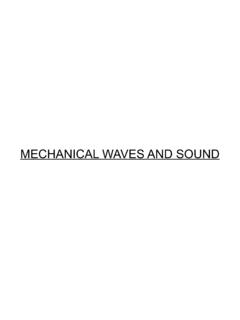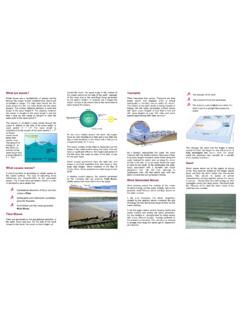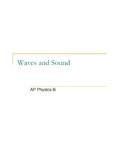Transcription of Waves in the Ocean - FCIT
1 Waves in the OceanIn this document we will discuss three types of Waves : wind-driven Waves , tides and tsunamis. When the wind blows on thesurface of the Ocean it produces ripples, Waves , and swell. Gravitational forces (mostly from the moon and sun) plus centrifugalforces in the solar system produce tides. Tectonic forces such as earthquakes that cause vertical displacements of the Ocean floor,submarine volcanic eruptions, landslides and meteorite impacts on the Ocean all cause typical periods, wavelengths, and forcing mechanisms of the Waves in the Ocean that we discuss are presented in the PeriodsWave lengthsForcing mechanismRipples< sec10-2 mwind on sea - 9 sec130 mwind on sea surfaceSwell9 - 30 sec100s of meterswind on sea surfaceTsunamis15 minutes - 1 hourfew 100s of kmseismicTidesseveral hoursseveral 100s - few 1000s kmgravitational (mainly sun and moon)The first class of Waves that we will cover is that produced by the wind blowing on the Ocean s surface.
2 Wind can generate waveslocally, called sea, which travel in different directions and at different speeds. Wind can also generate Waves that travel from aremote location in the open Ocean , called swell, which travel in one direction and are more regular than sea Waves . Ripples are thesmallest and most irregular undulations produced by wind on the sea surface. To study wind Waves , we should use ideal Waves withsinusoidal shape. We define the properties of Waves from these ideal Waves (Figure 1). The wave crest is the point of maximumelevation, and the wave trough is the point of minimum elevation. The wave amplitude A equals one half the wave height H, whichis the distance between the crest and the trough. The wavelength (the Greek letter lambda) is the distance between two crests(or two troughs or two inflection points with the same curvature above and below the points).
3 The period T is the time it takes onewavelength or two consecutive troughs (or crests or any other wave reference point) to pass by a fixed position. The speed C (Cstands for celerity) of the wave is the quotient of the wavelength over 1 The wave height depends on the energy transferred to the surface by the wind; it does not depend on C, , or T. As you probablyhave seen in the Ocean or a lake, the stronger the wind, the higher the Waves . The period and wavelength can be expressed in termsof their reciprocals, the wave frequency = 2(pi)/T, and the wave number = 2(pi)/ . ( is the Greek letter omega, and is theGreek letter kappa.) The frequency and the wave number are spatial and temporal analogs of each other: frequency is themeasurement of the number of repeating units of a propagating wave per unit of time, and wave number is the measurement of thenumber of repeating units of a propagating wave per unit of space.
4 The units of frequency are time-1, and the units of wave numberare should be noted that Waves do not change their period T. The wavelength is a function of T, and the celerity C is a functionExploring Florida: Teaching Resources for Science1 of 9 . Thus, long Waves travel faster than short Waves . The study of wind Waves is simplified by treating them as "small amplitude" Waves . Small amplitude means that the wave steepness, which is ratio of wave height H to wavelength , is smaller than onetwentieth, in idealized situations. In real cases, the steepness of small amplitude Waves is 1 wave celerity or speed depends only on the wavelength and on the water depth h. A deep water wave also called a shortwave is found where the wavelength is shorter than twice the water column depth, , < 2h.
5 Therefore, the celerity of a deepwater wave depends on the period (or on the wavelength because period and wavelength are related as = CT). Wave speed doesnot change with depth, in other words, the phase speed of a deep water wave is independent of depth shallow water wave or long wave is found where > 20h. For shallow water Waves , the phase speed, C = (gh) , depends onthe local water depth but not on the wavelength. This is an important relationship because it says that long Waves such as tidespropagating over coastal areas will have phase speeds that are proportional to the square root of the water Waves are those that fall between long and short Waves . The range of depths at which these Waves may existincreases with wavelength. There is an alternative way of representing the phase speed or celerity, in terms of the wave frequency :Equation 1 - The Dispersion RelationThis is called the dispersion relation because it relates the wave period (or its inverse, frequency ) to the wavelength (or itsinverse, wavenumber ).
6 This relation describes how Waves of different periods travel at different speeds and get sorted according totheir period. Deep water Waves are dispersive (get sorted) as their speed depends on and on their period T. This means thatshort Waves will travel at different speeds over a given depth. Hence, the Waves that travel fast will separate from the slow ones(Figure 2). In contrast, shallow water Waves are non-dispersive because their speed is independent of and T. The dispersionrelation (equation 1) leads to the concept of group speed of 2 Group SpeedThe group speed is the speed at which a group of Waves travel. This is illustrated by a series of distinct Waves that you see arrivingat the beach consecutively. The quantitative notion of group speed Cg is derived form the dispersion relation, by estimating thechanges of frequency with respect to the wave number, or the change of the wavelength with respect to the period (Figure 3).
7 Exploring Florida: Teaching Resources for Science2 of 9 3 The horizontal and vertical velocities of wave particles, as well as their displacements, describe circular trajectories for shortwaves (Figure 4) and elliptical trajectories for long Waves (Figure 5). Note that the shape of the wave is the feature that movescontinuously forward (at speed Cs). The wave particle velocities contribute little to the currents, except when the Waves have largeamplitudes in shallow 4 Exploring Florida: Teaching Resources for Science3 of 9 5In reality, wave shapes are not perfectly sinusoidal nor are their orbits perfectly closed. This is illustrated in Figure 6. Stokes driftbecomes important as wave grows and breaks. There is a net onshore transport produced by Stokes drift, markedly by long (shallowwater) Waves .
8 Furthermore, when these Waves arrive forming an angle with the coast they drive a current, a longshore current,between the breaking zone and the shore, , at the surf zone. This current is caused by the added mass of water that breakingwaves bring to the surf zone (analogous to the Stokes drift). Part of this added mass also causes rip currents, which are currentsdirected offshore for approximately one hundred meters. Rip currents form at an alongshore irregularity of the coast and may extendoffshore past the breaking zone. An additional current caused by this added mass on the surf zone is the undertow. The undertow istypically observed offshore of the breaking zone and consists of an offshore directed current, a few centimeters per second strong,that is strongest between the surface and the 6 Wind-wave alterations on their approach to coastsExploring Florida: Teaching Resources for Science4 of 9 experience modifications as they approach the coast.
9 These modifications consist of refraction, breaking, reflection, anddiffraction. The first two types of modifications are mainly due to bathymetric changes, or changes in water depth. Diffraction andreflection arise from an obstacle that hinders the energy propagation associated with the Waves move into shallow water their phase speed C decreases because C is proportional to the square root of the depth that the period T remains unchanged. The decrease in C causes then a corresponding decrease in wavelength because = CT. This decrease in with decreased depth causes the wave rays (lines orthogonal to wave crests) to concentrate over shoals andto diverge over bathymetric depressions (Figure 7) (bathymetric means relating to the depth of water). This has importantimplications for the distribution of wave energy at the coast, , energy convergence at promontories and points, and energydivergence at coastal indentations.
10 Refraction is then the change of direction of wave crests associated with the change of speeddue to 7 DiffractionDiffraction is the change of direction of wave crests associated with an obstacle. The obstacle can many times be a breakwater or aseawall. Diffraction develops in the "shadow" or "protected" area of the obstacle, , leeward of the wave direction of is the rebound of energy in the opposite direction to an incident wave due to the presence of an obstacle (Figure 8).Reflection occurs before the incident wave dissipates all its energy. The reflected wave develops over the exposed side of theobstacle, in contrast to diffraction, which develops on the protected side of the Florida: Teaching Resources for Science5 of 9 8 BreakingAnybody interested in the study of Waves has seen a wave breaking.












